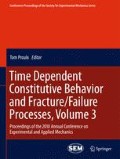Abstract
A new strain rate dependent material and failure model referred to as the M2C Model was generated suitable for modeling the static and dynamic material behavior of fiber reinforced composites. The M2C consists of an orthotropic viscoelastic constitutive model in combination with an enhancement of the Failure Mode Concept (FMC) of Cuntze for dynamic loading conditions and was implemented into the finite element Code LS-DYNA3D as user defined material model. A [0°|90°] glass fiber reinforced composite was investigated under different types of loading and loading directions within seven orders of magnitude of strain rate. The finite element results are compared with experimental results. In the principal loading directions and under arbitrary loading conditions an impressing agreement was achieved.
Access this chapter
Tax calculation will be finalised at checkout
Purchases are for personal use only
Preview
Unable to display preview. Download preview PDF.
References
Song, B.; Chen, W.; Weerasooriya, T.: Quasi-static and dynamic Compressive Behavior of a S-2 Glass/SC15 Composite, Journal of Composite Materials 37 (2003), p. 1723–1743, 2003.
Harding, J.: Effect of strain rate and specimen geometry on the compressive strength of woven glass-reinforced epoxy lamainates, Composites 24 (1993), Vol. 4, p. 323–332, 1993.
Tasdemirci, A.; Hall, I. W.: Numerical and experimental studies of damage generation in a polymer composite material at high strain rates. In: Polymer Testing 25 (2006), p. 797–806.
Aboudi, J.: A continuum theory for fiber reinforced elastic-viscoplastic composites. Int. J. Eng. Sci. 20 (1982), Vol. 5, p. 605–621, 1982.
Aboudi, J.: Effective constitutive equations for fiber reinforced viscoplastic composites exhibiting anisotropic hardening. Int. J. Eng. Sci. 21 (1983), Vol. 9, p. 1081–1096, 1983.
Bennett, J. G., Habermann, K. S.: An Alternate Unified Approach to the mechanical Analysis of Composite Materials, J. Compos. Mater. 30 (1996), Vol. 16, p. 1732–1747, 1996.
Hill, R.: A theory of the yielding and plastic flow of anisotropic materials, Proc. Roy. Soc. London 193 (1948), Vol. 1033, p. 281–297, 1948.
Hashin, Z.: Failure criteria for unidirectional fiber composites, Journal of Applied Mechanics 47 (1980), p. 329–334, 1980.
Puck, A.: Festigkeitsanalsyse von Faser-Matrix-Laminaten: Modelle für die Praxis. Carl Hanser Verlag München Wien, 1996.
Cuntze, R. G.: The Failure Mode Concept - A New Comprehensive 3D-Strength Analysis Concept for any Brittle and Ductile behaving Material. Proceedings European Conference on Spacecraft Structures, Materials and Mechanical Testing, Braunschweig, 4. - 6. Nov. 1998 (ESA SP 428, Feb. 1999), European Space Agency, 1998.
Cuntze, R. G.; Freund, A.: The predictive capability of failure mode concept-based strength criteria for multidirectional laminates. Comp. Sci. Tech. 64 (2004), p. 343–377, 2004.
Cuntze, R. G.: The predictive capability of failure mode concept-based strength criteria for multidirectional laminates. Part B., Compos. Sci. Tech. 64 (2004), p. 487–516, 2004.
Soden, P. D.; Kaddour, A. S.; Hinton, M. J.: Recommendations for designers and researchers resulting from the world-wide failure exercise. Comp. Sci. Tech. 64 (2004), p. 589–604, 2004.
Mayer, M.: Modellierung des statischen und dynamischen Materialverhaltens faserverstärkter Kunststoffe, PhD. Thesis, TU Chemnitz 2010, to be published.
Meyer, L. W.; Mayer, M.: Static and dynamic material behavior of fiber reinforced composites – Modeling and Testing, Presentation at the International Symposium on Plasticity 2009, St. Thomas, U.S. Virgin Islands, January 3–8, 2009.
Mayer, M.: Modellierung des statischen und dynamischen Werkstoffverhaltens faserverstärkter Kunststoffe, Presentation at the 5th Nordmetall Kolloquium, 2.-3.12.2009, Adorf, 2009.
Author information
Authors and Affiliations
Corresponding author
Editor information
Editors and Affiliations
Rights and permissions
Copyright information
© 2011 Springer Science+Business Media, LLC
About this paper
Cite this paper
Meyer, L.W., Mayer, M. (2011). New Strain Rate Dependent Material Model for Fiber Reinforced Composites. In: Proulx, T. (eds) Time Dependent Constitutive Behavior and Fracture/Failure Processes, Volume 3. Conference Proceedings of the Society for Experimental Mechanics Series. Springer, New York, NY. https://doi.org/10.1007/978-1-4419-9794-4_24
Download citation
DOI: https://doi.org/10.1007/978-1-4419-9794-4_24
Published:
Publisher Name: Springer, New York, NY
Print ISBN: 978-1-4419-9498-1
Online ISBN: 978-1-4419-9794-4
eBook Packages: EngineeringEngineering (R0)

